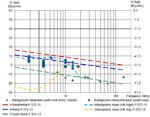Darvin1555
Newbie
Hello everyone.
Recently my chief has given me task to think about receiving part of our prospective system and additionally told that i should search for LNA with the lowest possible noise. Unfortunatelly im not RF circuits engineer, but nonetheless i have read necessary chapters from popular books like Microwave engineering by Pozar, and nowadays im slightly aware about principles of RF circuits design. But i decided to not design LNA, because i dont have much time and proper experience and i have been looking for appropriate LNA throughout all manufacturers. But i still have some questions. Receiver in the system will work with set of narrowband frequencies (15-30MHz for example.), but this set will be below 100MHz. And as far as im concerned at this frequencies there are a lot of terrestrial noise sources, judging by Internationall Telecommunication Unit recomendations, and this dependece works regardless of location of system (our will be located at bare field far from cities). And questions:
Recently my chief has given me task to think about receiving part of our prospective system and additionally told that i should search for LNA with the lowest possible noise. Unfortunatelly im not RF circuits engineer, but nonetheless i have read necessary chapters from popular books like Microwave engineering by Pozar, and nowadays im slightly aware about principles of RF circuits design. But i decided to not design LNA, because i dont have much time and proper experience and i have been looking for appropriate LNA throughout all manufacturers. But i still have some questions. Receiver in the system will work with set of narrowband frequencies (15-30MHz for example.), but this set will be below 100MHz. And as far as im concerned at this frequencies there are a lot of terrestrial noise sources, judging by Internationall Telecommunication Unit recomendations, and this dependece works regardless of location of system (our will be located at bare field far from cities). And questions:
- Could anyone point article or datasheet where i can find dependence between temperature and NF for LNA for temperature between -200C and -40C? I have seen some articles concerning cryogenic LNAs, but almost all charts with dependencies were measured at -200C, neglecting intermediate temperatures.
- Is there any point to design cooling sytem to decrease temperature of LNA bellow lowest operating temperature from datasheet and has anyone had any experience concerning reliability of LNA at low temperatures?
